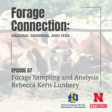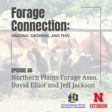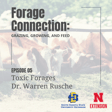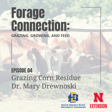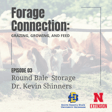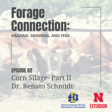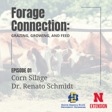Become a Creator today!Start creating today - Share your story with the world!
Start for free
00:00:00
00:00:01

A Commercial Growers Perspective: Jory Freeburg
Jory Freeburg from Freeburg Hay chats with us about being a commercial hay grower; production practices, working with clients, and spring preparation.
Transcript
Introduction to Jory Freeberg and Family Farm
00:00:05
Speaker
It's the Forage Connection, grazing, growing, and feed with your hosts, Ben. And Sarah. Today with us, we have Jory Freeberg. Jory is one of the operators of Freeberg Hay, located near Vermillion, South Dakota. Freeberg Hay is a commercial off-elf operation and farm. And Jory operates the farm with his parents, Amy and Gary, and his brother John.
00:00:31
Speaker
And I know they're busy folks. I don't live far from the area and drive past their farm. It's hustling and bustling all the time. So we're excited to have you with us today, Jory.
Overview of Freeberg Hay's Operations
00:00:42
Speaker
Jory actually has a business degree from Mount Marty in Yankton, and he has been back at the farm for quite some time. So today,
00:00:49
Speaker
Our plan is to talk about what goes on at Freeburg Hay, maybe how the structure looks, and some insights from a commercial hay grower, because this part of the state in southeastern South Dakota has a few commercial hay operations, but for the vast majority of folks in the Midwest, in our region, Nebraska, South Dakota area, it's not something we commonly think about. So we thought it would be fun to talk to someone who spends most of their time focusing on alfalfa hay.
00:01:19
Speaker
So thanks for joining us, Jory. Yeah, sure thing. So before we get too far, uh, can you just tell us a little bit about Freeburg? Hey, just a general overview of where you're at, uh, what you raised there and maybe your business structure. Yeah, sure. So we're, uh, in the Southeast corner of South Dakota, kind of three miles to the west of her man.
00:01:46
Speaker
We farm in the river valley that runs from Yainton to Vermea. The river valley is about probably 10 miles wide, you know, north to south and long. It's probably, you know, 26 miles long. So our farms are kind of spread out across it.
00:02:09
Speaker
As far as the business structure goes, we're a family farm. We grow alfalfa, alfalfa orchard grass for dry hay. And we also have corn and soybeans. I would say about 60% of our acres are irrigated. The rest is dry land and corners. What else were you looking for?
00:02:32
Speaker
So maybe the history of the operation, how did it get started? Have you always been a commercial hay operation or did that evolve with time?
History and Jory's Involvement in the Farm
00:02:42
Speaker
Yeah, so it kind of started out when my dad was in high school. He had a straight truck and he would buy and sell from local farmers. My grandpa was a smaller farmer. He also helped a lot of farmers in the valley here.
00:02:56
Speaker
The dad got back from Vietnam and he started buying land and farming. And, you know, I would say probably by the time the mid to upper eighties, we were maybe up to commercial size as far as Hain, a Hain operation would go.
00:03:14
Speaker
That's, that's a pretty neat backstory and a lot of things come, you know, from small roots. So it's fun to hear about that. Um, have you been involved since early days, um, as an adult jury or how did your involvement begin? Yeah. So I started helping, oh, probably, you know, I drove a tractor as young as 10, but my grandpa was coming to pick me up to go over AK as.
00:03:39
Speaker
You know, as early on a consistent basis is when I was, you know, 12, 13 years old. Um, I was running a big square Baylor probably by 13 years old. So, I mean, I've been, I've been involved in farming, you know, with my parents and with our family since, you know, the late eighties. So plenty of experience. Yeah, a little bit.
00:04:03
Speaker
So when you're doing, you're mostly off alpha, a little bit of off alpha grass mix. What's your primary market for that, Jory? Are you going for dairy market? Is there another group that you're targeting or kind of where are you selling or producing that to sell for?
Target Markets and Regional Demand for Hay
00:04:22
Speaker
Yeah. So we're always shooting for the best dairy hay we can put up. I mean, weather dictates a lot around here. You know, we can get a lot of rain at times.
00:04:31
Speaker
being, you know, just on the Western edge of the corn belt here. So just to pay on the year depends on how many, how, what the percentage of our total tons for the year get put up as dairy hay. We're always shooting for as much as we can get. I mean, I think we're happy if we can get around 60% of our total tons up as dairy hay. The last few years have been on the dry side and we've done better than that. You know, a higher percentage than that has been put up as dairy hay.
00:04:58
Speaker
Um, some of our hay goes to the horse market to Florida. Um, you know, Eastern seaboard, that type of thing, not a big percentage, but some does. Um, you know, the rest of the hay we, that doesn't make grade, you know, we try and sell the feed lots. We have a grinder and deliver some ground hay. Um, we also do some business with some pelleting mills that make alfalfa pellets and the, and they generally buy, you know, some of the lesser quality stuff. Um,
00:05:26
Speaker
You know, you always got to find the home for everything on an operation like ours. We don't have any livestock, so we can't burn any of it off that way. So we're always just trying to find a home for all of it. We're pretty successful at it. We've usually found a home for every bale every year. So it's probably a little bit like a game some years, just trying to make sure that you can utilize everything that you put up. I'm sure that gets to be a bit of a challenge.
00:05:53
Speaker
Well, it can be, and I mean, you just never know where the lean parts of the country will be for hay, you know? I mean, some years we'll sell some hay in Texas and Oklahoma, and then we'll go on years and years where we won't sell any that way, you know? There's plenty of hay in Kansas and Oklahoma and even part of Texas to fill those needs, but some years they get really dry down there, and then some hay will move that way, you know? Same way with Wisconsin, like some years they have really good years putting up alfalfa
00:06:21
Speaker
and they're pretty set for the most part, but then other years, you know, they'll catch a lot of rain or they're really susceptible to winter kill at times, you know, and then they'll be short. So you just got to kind of move it around. I mean, we have our steady customers, they're there year in and year out, but you know, the other percentage, you kind of got to search around and find a place and where it needs to go. You know, it's almost like grain movement, you know, when it's dry in a certain part of the country.
00:06:50
Speaker
and grain needs to move, you know, east or south or it's the same, you know, dynamic kind of for alfalfa or dry hay, you know.
Production Techniques and Challenges
00:07:00
Speaker
You know, when you look geographically, is most of your sales then for the most part regional or are you just chasing wherever that market's at? You've kind of got a finger on that and you're going where the demand is. Yeah, I would say a lot of our sales are regional, you know what I mean? Well,
00:07:17
Speaker
We'll haul the local stuff with our own trucks, but if it gets farther than 150 miles out from the farm, then we'll hire a freight truck to haul for us. But a lot of our year over year customers, they're in the region and most of it off to the east. Looking at producing that dairy quality hay, we've got a lot of producers around this country or this neck of the woods that are happy with
00:07:47
Speaker
Hey, for their beef cows, you know, you put it up in a round bale, you store it outside. As long as it's decent quality, it's good enough. Are there some particular things that you're looking for, you know, to bump you up to that next level to make sure that it's quality or is it really just kind of fall down to the timing of the cutting and just hitting that window perfectly and getting some nice weather to put it up or are there some other things that you're looking at?
00:08:15
Speaker
Yeah. I mean, you got to start with cutting on, you know, around a 26 to 28 day schedule. If you're even going to try and make good dairy hay, I mean, you got, you got to stay on that. Otherwise, you know, you get past 28 days, like every day that goes on after that, you know, you're losing RFE just because you know, you're getting into the bud stage and then pretty soon it's blooming. And so we're, we're always trying to get on the 2028 day schedule.
00:08:44
Speaker
I know there's commercial hay growers that have different theories about cutting schedules. And like you mentioned, 28 days, that four-week mark is pretty common. Do you have a game plan or a theory that you use for cutting regardless of rain? Because I've talked to some hay growers that will say, we keep a 28-day schedule. So if it rains, it rains. And other commercial hay growers are more lean on the side of we're just going to wait until that hay is dry.
00:09:11
Speaker
So I know it goes both ways. Curious if you have something you follow every time or if you just adjust as the weather happens. Yeah. So the most part we just try and keep to 28 days because you know, you start, you start going past that just chasing the green. Hey, um, you know, pretty soon you'll start to cut your, your season will get too short up here. So you can start to lose cuttings. And I mean, we're always shooting for, for four to five cuttings. We don't always cut.
00:09:39
Speaker
everything five times every year, but a lot of years we'll cut it all five times. And I mean, if you don't stay on 28 day schedule, you're not going to cut five times. You're going to run out of calendar. You're going to run out of, you know, you're going to run out of growing season. So we always try and stick to that. And now, I mean, if it's raining too much and the fields are too wet, sometimes you don't have a choice. Then you just got to sit back until you can go again, you know, but if we can, we try and keep to that.
00:10:06
Speaker
28 days, that allows us to usually cut five cuttings on everything, not always, but usually, you know, with like new seeding with the irrigation that we have now, you know, back in the day, if you got two cuttings or three cuttings on dry land, new seeding, you were doing, you know, you were happy with that. But now with as much irrigation coverage as we have and on the irrigated acres, I mean, we're always trying to cut even new seeding four times a year.
00:10:34
Speaker
a few questions on the management side out of curiosity with that five cutting schedule. Do you typically leave your stand in for a set number of years or do you assess by how many plants per square foot you have?
Crop Rotation and Soil Management
00:10:47
Speaker
Yeah, so that all just depends. I mean, we're always shooting to get five years out of a stand of hay. So that's, you know, the new seeding year plus four more full production years.
00:10:59
Speaker
So that's, that's generally what we hope to get. We usually don't get more than that here. Um, we're pushing it pretty hard all the time, you know, cause we're, we're cutting, we get off the field, we turn the irrigators on for a quick pass, try and get the hay going good. You know, so we're always pushing it to get the five cuttings. The other thing that's hard on stands and why stands don't last as long as what they used to, I believe,
00:11:25
Speaker
Is that, uh, you know, the heavy balers, the tractors, all the equipment's bigger. We were on some eyes out on the fields, all that compaction stuff. It's, it's just harder on the stand. So, I mean, if you get five good years out of a stand around here, I feel that we're doing good. Especially with your five cuttings. Um, if you're not having winter kill problems or, I mean, some years I'm sure we all have winter kill problems in this area, but.
00:11:52
Speaker
The five cuttings in five years, that's pretty impressive. I'm sure the irrigation helps that along, but I'm sure you have a pretty rigorous fertilizer schedule as well. You make sure you're not stressing your plant with soil fertility and things like that. So I would agree that's, that's a pretty, pretty nice cutting schedule to get five years out of it for sure. When you're cutting dairy quality hay like that. Yeah.
00:12:16
Speaker
Yeah, we just don't seem to get much more than that out of it, the way we're pushing it. And it is important. You want to have the basics right out there. You got to have the P and K out there and keep the bugs out of it. All those are big factors. You mentioned before that you've got a couple of fields that you do some alfalfa grass mixes too.
00:12:36
Speaker
Um, is that stretching out some of those stands that might've gotten a little thinner? You know, we see that as a strategy sometimes, or, or do you see, you know, initially an alfalfa grass mix and have a purpose for doing that right off the bat? Yeah. So generally on most of our acres that we grow a mix on, we'll see that from the start like that we'll put the grass and the alfalfa together. And, you know, just like if we were going to plant a straight alfalfa field.
00:13:01
Speaker
only it's got some grass mixed into it. I do have one field that, you know, we're trying to stretch a stand on, but it's kind of an outlier on our farm. It's a hilly, highly erodible piece, which we don't have much of. Um, that one, I'll just air seed grass into it and just kind of keep the alfalfa in it. But for the most part, if we're going to do something on the river bottom here, uh, we'll plan it at the same time. The alfalfa and the grass with our drill, we got two boxes on it. So we got a,
00:13:31
Speaker
a grass box and then, you know, seed box. So it's got, it's got two, so it all gets done in one pass. You've got some customers that are specifically looking for that, that mix then. Yeah, we do. I mean, it's, it sells good. If you can get it up, if you can get it up nice, I mean, it's pretty, and that's what everybody wants, but the challenge is, you know, if you, if you're getting a lot of Dewey weather or high humidity weather, I mean, grass turns brown so easy. And I mean, everybody that's looking to buy alfalfa,
00:14:01
Speaker
Grass mix, they want it pretty and green. Yeah, that visual thing has a lot to do with selling hay, doesn't it? It's huge. Sometimes it's everything. Yeah, it doesn't matter what the quality is sometimes. If it doesn't look good, it doesn't look good. So keeping that
00:14:22
Speaker
in mind, you know, you have a couple different mixes, it sounds like you plant, you know, the grass alfalfa, you have the straight alfalfa. If you're in for five years with your alfalfa, what does your rotation away look like? How long are you out of alfalfa? And do you have certain crops you put in between? Or is it different depending on the field in the year? Yeah, so when we're going out alfalfa, we're always trying to go corn into it to get the nitrogen bump that's left over.
00:14:49
Speaker
So it's always corn, then beans, then corn, then beans, then maybe back to hay, or we might run another cycle of corn and beans. I mean, ideally four years out or six years. We have went back after two years, like a year of corn and a year of beans and then back, but it gets pretty tough on the soil over time. So four is better for sure.
00:15:15
Speaker
And then the other thing is we always like to plant into bean stubble. It's just way less trash. You get a better stand. You know, corn, you got all that organic matter out there, which is great. But I just feel like you get a lot better stand out of a bean stubble field, you know, if you're going for a new seeding hay.
00:15:36
Speaker
Yeah, alfalfa is pretty fussy with that seed to soil contact and depth. So that does make sense. Are you no tilling it in then or are we tilling that stubble under? Yeah. So on our bottom here, we'll usually disc it lightly in the fall. Just, you know, usually you can still see the rows. We're on 30 inch rows for the beans. Usually you can still see the rows, you know, when you drive by and pick up or whatever. So we're not going deep with the disc, but just enough to kind of size up the beans stubble matter.
00:16:06
Speaker
And then the spring will go out there with soil finisher and hit it twice. So we'll go, you know, kind of at a diagonal one direction, then come back to the other. So it's two passes. That's a lot of work. Some people think it's not necessary, but we're always trying to get the field as smooth as we can to start with, you know, cause all you're going to do over the next five years is put ruts in it or, or imperfections, you know, so we're always trying to get as good as we can to start with.
00:16:34
Speaker
The other thing with that second pass is it does firm it up really nice. So I mean, we think it's
Seeding Techniques and Weather Challenges
00:16:40
Speaker
worth it. We do it, you know, so especially the other thing too is, you know, we're cutting with this binds and I mean, you cut about 10 to 12 miles an hour with them. And you know, you want to be smooth to start with smooth as you can. If you're going 10 to 12, you certainly don't want a rough surface. That's for sure.
00:16:59
Speaker
So dare I ask of what type of equipment, and if you don't want to name brands, you don't have to, but what type of equipment do you seed with? Do we seed with? Yeah, so we use a Kraus press drill. It's on six inch spacing. A lot of guys will use seven and a half or use like a brilliant seeder, but we kind of like the tight press drill spacing.
00:17:28
Speaker
Over the years, we, we've had some stands blow out with, uh, brilliant before. So we went back to the press drill and, and it just seems to do the best job for us in our conditions. Sure. And you're typically putting in a straight up alpha stand. You're not using a companion crop or anything when you're putting that in initially in the spring. No, we've kind of quit with the oats as a companion crop, you know, for quite some time now.
00:17:56
Speaker
close to 30 years, probably, we're always just going straight off alpha. With your rotation, you probably have your weeds pretty well mastered and under control. And maybe that's part of that, not needing a nurse crop anymore, I'm guessing. Yeah, no, that's correct. I mean, the chemicals and different chemical plants for corn and beans has definitely helped, you know, have our fields be in a cleaner state when we go to them. So yes, that's, that's definitely a factor, you know,
00:18:27
Speaker
And is it always a spring seeding jewelry or do you sometimes do a fall seeding? So we're always shooting for a spring seeding. Now we have done some August seeding before, but it's never seemed to work great for us. I just think it's a little bit hot around here to really get that to work good. I have friends in other parts of the country that do real well, like they'll plant wheat, take that wheat crop off and then that fall, they'll fall seed it and it works good for them. But I don't think like the friend I'm talking about in particular,
00:18:57
Speaker
he's kind of in the thumb of Michigan. And I, you know, I just think his temperatures are a little bit more steady that time of year. That's just, you know, they don't get to 90 plus degrees like weekend, you know? Yeah. That bipolar weather issue is always the problem here. Yeah, it is. I mean, we just have such huge swings, you know, we can, we can be pretty moderate some August and then the next one is really hot and dry.
00:19:24
Speaker
So speaking of temperature swings and everything, with spring coming on here and we've had some pretty warm days, is there anything that you're looking at? Are you doing some field scouting? How are things looking this spring for your upcoming season? Yeah, so it's funny you asked that. I just walked a couple of fields last night, and it's pretty much broke dormancy, which is really early for us.
00:19:52
Speaker
It's a little bit concerning, but the other thing is we're on the dry side. So if we were on the wet side, I think it'd be probably pretty bad because if you caught some really cold weather for a few days, it can get pretty rough on it. I think being on the dry side is probably going to help us with this early dormancy break, but you just never know. I mean, there's so much time yet before the weather moderates. I hate to say we're home free or anything.
00:20:22
Speaker
I would say the plants and everything look really good right now, but I mean, I'm just cautious about it just because we're so early and you just never know. Are you concerned at all? We've had some discussions with some of our forage folks down here in Nebraska with it just being so warm, so early, just from the insect side of things, really keeping an eye out for some early insect pressure this year. Is that something that's on your radar?
00:20:52
Speaker
Yeah, for sure. It always seems like when it's warmer, a warmer spring like this, and then if you get a lot of south wind, it seems like it can push a lot of bugs up. So I mean, yeah, we'll be watching for it as soon as it makes sense to. So it'll definitely be on our radar. And they probably will be, it'll probably be above average bug gear this year if I had to guess just with the way things are right now.
00:21:18
Speaker
Yeah, I was listening to one of our entomologists speak not too long ago, and I did not like the anecdotal prognosis of having issues with insects early just because of the strange temps we're having in mild winter. But like you said, on the alfalfa side, at least we went in in this part of the world, even on the river bottom there, we kind of went into the fall fairly dry.
00:21:44
Speaker
So that helps with the winter kill issues. Sometimes the plant doesn't have as much moisture in it and the cells don't rupture as easily. But I think that the early dormancy in it coming up now could be, we'll see, could be concerning, especially with the insects. I guess we're going to find out, right? Yeah. Well, the other thing is, is usually when it greens up this early and gets going, usually it gets froze off once or twice, you know, it'll,
00:22:08
Speaker
It'll get to the point where it's starting to blow in the wind and really look good. And then you'll get a couple nights that'll dip down to 26 and kind of lay it over and set it back. If I had to guess, that's probably going to happen this year. But time will tell. Hopes are dashed quickly. You think you're going to cut early, like maybe mid-May or something. And usually rule of thumb around here right around
00:22:37
Speaker
the end of May to the first part of June, you know, we usually lay the first day down, but I mean, we have cut earlier before, but I really think we'll probably get set back at some point and it'll just land where it always does. You know? Yup. Yup.
00:22:52
Speaker
So we've discussed a lot on the growing side. How about on the end product side?
Hay Storage and Inventory Management
00:23:00
Speaker
So once you have your hay baled, well, I should ask, do you do mainly large squares, rounds? Do you do any, any of the little guys, you mess around with those? What does your end product typically look like? Yeah, so we've always stuck with a three by three by eight bale. So you know, roughly 900 pound big squares.
00:23:21
Speaker
Um, so that's, that's what we have. I mean, we'll buy three by fours. We'll buy some round bales to grind once in a while, but our, our balers were running for a three by three balers. And is everything stored under roof? I know driving by, it's obvious that a lot of the hay is under roof or do you have some of the lower quality stuff you can store outside? So yeah, most everything's always underneath a roof. If we have some marginal hay that we got to get off a field or something, we'll stack it. Um,
00:23:50
Speaker
we got to gravel a lot to the east of our farm. We'll stack some of that outside or if we're running short on shed space at the time or whatnot, we'll stack a little bit outside if we have to, but we try not to. So a couple of years ago, we never stacked anything outside. I think it was probably the 2022 season maybe, but that's kind of rare for us. Usually we get a little bit outside, but
00:24:15
Speaker
it's a small part of our overall production, most all of it, even if it's lower end stuff goes underneath the roof. Sure. Yep. Well, I knew that a lot of your hay is under roof, obviously just from from going by the place, but it's always kind of
00:24:30
Speaker
fun to compare the commercial hay grower to some little guy like our family farm. We don't have a roof to put the hay under, but you do the best you can. So it's that high quality product though. You want to keep it as long as you can. And speaking of which, do you have kind of a timeframe you try to move the hay or is it just depending upon the year? I mean, obviously with your roof space, you don't want to keep it too long, but you have the ability to do so, right?
00:24:58
Speaker
Well, yeah, we could keep it theoretically forever if we wanted to or anything rough. But we try and get pretty well cleaned out by the end of May, sort of. We always try and carry some hay over. Just some people don't want fresh hay right away. They want to sit on the place for a month or something before we ship. So if we cut the 1st of June, the soonest we could ship to some of those guys would be the 1st of July. Well, always somebody calls and needs something in June there.
00:25:28
Speaker
We always like to have options for people. Plus, we don't like to really grind fresh, really fresh hay. We like to have some old hay, so to speak, to run through the grinder. So, I mean, we don't ever try to fully clear out a hay, but we try and get real close, you know? Yep. Just want to make sure you have space for the new stuff. Yeah. Just want to be ready for the new year once we get going. So, you know, hay doesn't move as fast, you know, traditionally during,
00:25:57
Speaker
June, July, August, just cause everybody else is busy farming and, um, you know, usually guys have planned ahead. I mean, we're always shipping. Hey, every month, all the time, but you know, generally the production months are a little bit slower for the shipping. So you want to make sure you got room for it. Absolutely. And you do a lot of your own shipping, it sounds like. Yeah. So we run four trucks on our farm. Um, we'll deliver local loads here.
00:26:24
Speaker
but otherwise we're lining up freighters to come in and haul it for us. Either we ship it or we line up the shipping for the most part. Some of our customers will send their own trucks in, but most of the time we're lining up the trucking. Sounds like a hustling, bustling place. You got plenty going on there. Yeah, every day is interesting. Let's just put it that way.
00:26:48
Speaker
Well, earlier you and Ben were briefly mentioning the sale
Ensuring Quality and Consistency in Hay Production
00:26:53
Speaker
of hay. And we talked about the visual quality of hay. And that's one thing I think that's always fun to ask commercial growers is, what do you think a hay buyer looks for in a product like yours? We discussed that visual is important, but what else do you see a lot of your buyers looking for? Most buyers that show up here, they're looking at our barn products. So you never have any
00:27:19
Speaker
damage on the side bales. You don't ever have any damage on the top bales. And then there's no mold. There's no wicking on the bottom bales because our barns all have an asphalt floor in them. So I mean, really every bale looks the same that we pull out. It's consistent. I mean, I think, I think a lot of buyers really appreciate and look for that. Um, you know, I know not everybody has as much barn space as we have, but I mean, at the very least guys should be tarping, you know, their better quality hay.
00:27:49
Speaker
at the very least, unless you just have a round baler and that is what it is. And actually, a good solid net wrap round bale keeps pretty good. It's pretty impressive, but it's hard to ship round bales long distance. You just can't do it. So you're over height, you're over width. You can only go so many miles away from the farm with a round bale. Well, I think that covers a lot of the,
00:28:18
Speaker
info and it's really fun and interesting to learn about operators, especially in your situation where you're really focusing on alfalfa hay. We really appreciate, you know, the time that you took to share with us. And I think before we go, one important thing that might be helpful to listeners is if I was a new grower getting started in high quality alfalfa hay production or someone transitioning
00:28:48
Speaker
to that market.
Advice for New Growers and Industry Networking
00:28:49
Speaker
What suggestions or tips would you give someone at that point? I guess I would say try and create a product that's as consistent as you can. If you get it put up dry and it looks good and it's green, even if you don't have a shed to put it in, at least get it tarped and try and park it in a well-drained area where you're not getting wicking and that sort of thing.
00:29:18
Speaker
The other thing, if you're really wanting to be a commercial producer and focusing on quality, I mean, you always want to start with the basics, try and cut the hay in the pre-bud, maybe early bud stage. That would really be my best advice, I guess.
00:29:39
Speaker
Are there any places for support resources that you use that you'd suggest, you know, if somebody's getting started, whether that's, you know, professional organizations or certain publication magazines or anything like that, that would be a good resource as well to share with folks? Yeah, so my parents have been active in the National Hay Association since the early 80s. And that really helped my dad get going before he was even the commercial size.
00:30:09
Speaker
It's a like-minded organization full of a lot of commercial hay producers. It also has a lot of exporters, guys from the West Coast that export hay, a lot to China, Japan, Korea, Saudi Arabia, that sort of stuff. But that organization has a monthly publication that comes out. And if growers were to join the organization and show up to the meetings
00:30:39
Speaker
showing up to the meetings is really where the value is at with it. Just because you talk to so many different people, see how they're doing things. You get a lot of ideas of what you can do to take your operation to the next level, so to speak. It's just full of a lot of incredible hay producers. So that would be one thing. I mean, the other publications that are out are all good too. I mean, they all come to our farm just like everybody else's.
00:31:07
Speaker
But the National Hay Association would probably be a good place to start if you're really thinking about transitioning to more of a commercial grower. Sure. Just making those industry connections and starting to build that network up. Yeah, for sure.
00:31:24
Speaker
Well, Jory, we really appreciate the info and the time. I know sometimes it's hard to share about your own business, and there's of course things that you don't share with the general public, but we really appreciate all the info that you've given us, and I think that this could be really valuable to growers, you know, whether they're in this Southeastern, South Dakota, Northwest Nebraska,
00:31:45
Speaker
Excuse me, I can't stop. Southeastern South Dakota, Northeastern Nebraska area or not. I think this is all really good information and appreciate your networking and contact suggestions too there. Is there anything else you would want to share for the greater good of the cause before we wrap it up? I don't know. Probably just always strive to do the best you can and that's probably
00:32:15
Speaker
the best thing to get you to where you want to be. It's never going to be easy out here. It's always a challenge and you just got to take the challenges on whether it be the weather or the market or whatnot and just keep striving to do the best you can with what's put out in front of you. I mean, that's farming in a nutshell a little bit. Absolutely. I love your comments on hay storage because that's
00:32:43
Speaker
big thing that people overlook. You work so hard to put up the hay and then so oftentimes it's not stored very well and people don't even realize that. So those are great tips as well, you know, and we have a lot of info on that too. Ben and I did a little demonstration on that a few years back and that was a really, really telling one. It was in 2019, you know, when it rained inches and inches. Oh yeah.
00:33:07
Speaker
So that was a fun one. So if you have interest, more interest in hay storage, check out the SDSU Extension website. Just look up round bale conservation and you can find all that. But it was great to hear you, to hear you comment on that too. Yeah. Well, I mean, you get it all up perfect and everything, and then you don't get it stored, right? And I mean, you can lose half your value just in that.
00:33:34
Speaker
Well, Jory, we appreciate you taking some time chatting with us today. Thank you to all of our listeners for joining us on The Forage Connection.
